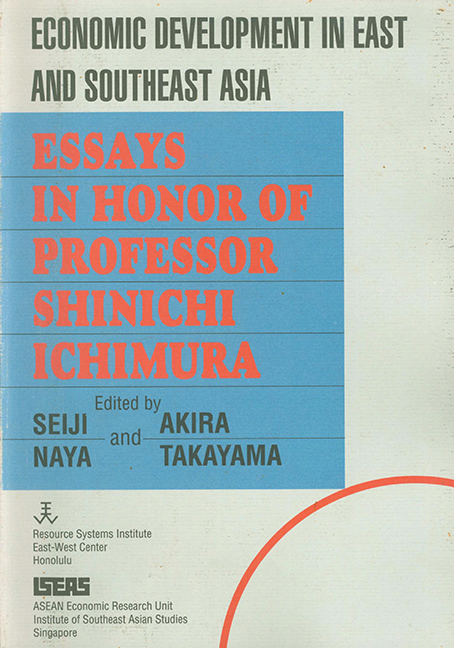Book contents
- Frontmatter
- Preface
- Shinichi Ichimura, 1925-
- CONTENTS
- Introduction
- Contributors to This Volume
- I Structural Change and Economic Development in Developing Asia in the 1990s
- II Explaining the Success of the Four Little Dragons: A Survey
- III Taiwan's Economic Miracle: A Singaporean Perspective
- IV Singapore's Experience of Industrial Restructuring: Lessons for the Other Asian NIEs
- V Korean Industrial Policies for Declining Industries
- VI Vietnam: Recent Economic Developments and the World Economy
- VII Transition from Import Substitution to Export Expansion: The Thai Experience
- VIII Adjustment Problems of a Small Oil-Exporting Country: Did Indonesia Suffer from the Dutch Disease?
- IX A Quarterly Econometric Model of the Hong Kong Economy
- X The Effect ofRicardian Rent Extracting on Macroeconomic Performance
- XI Direct Foreign Investment and the Economic Development of Korea
- XII Japanese Investment in Thailand: Looking Back and Into the Future
- XIII The Effects of Direct Foreign Investment on Taiwan: A Macroeconometric Investigation
- XIV A Reform of the Foward Foreign Exchange Market and Foreign Exchange Rate Determination Policy in Korea, with Foreign Exchange Policy Experiences of Taiwan
- XV Interest Rate and Foreign Exchange Liberalization in Taiwan in the 1980
- XVI Manifold Dilemmas behind External Debt Management
- XVII Agricultural Growth and Food Imports in Developing Countries: A Reexamination
- XVIII The Transformation of Rural Asia and Economic Development Theory and Policy
- XIX The ASEAN Summit and ASEAN Economic Cooperation
- XX The Role of Developing Countries in the New GATT Round
- XXI The Emerging Global Economy and the Role of the Asian NIEs
- Index
VII - Transition from Import Substitution to Export Expansion: The Thai Experience
Published online by Cambridge University Press: 21 October 2015
- Frontmatter
- Preface
- Shinichi Ichimura, 1925-
- CONTENTS
- Introduction
- Contributors to This Volume
- I Structural Change and Economic Development in Developing Asia in the 1990s
- II Explaining the Success of the Four Little Dragons: A Survey
- III Taiwan's Economic Miracle: A Singaporean Perspective
- IV Singapore's Experience of Industrial Restructuring: Lessons for the Other Asian NIEs
- V Korean Industrial Policies for Declining Industries
- VI Vietnam: Recent Economic Developments and the World Economy
- VII Transition from Import Substitution to Export Expansion: The Thai Experience
- VIII Adjustment Problems of a Small Oil-Exporting Country: Did Indonesia Suffer from the Dutch Disease?
- IX A Quarterly Econometric Model of the Hong Kong Economy
- X The Effect ofRicardian Rent Extracting on Macroeconomic Performance
- XI Direct Foreign Investment and the Economic Development of Korea
- XII Japanese Investment in Thailand: Looking Back and Into the Future
- XIII The Effects of Direct Foreign Investment on Taiwan: A Macroeconometric Investigation
- XIV A Reform of the Foward Foreign Exchange Market and Foreign Exchange Rate Determination Policy in Korea, with Foreign Exchange Policy Experiences of Taiwan
- XV Interest Rate and Foreign Exchange Liberalization in Taiwan in the 1980
- XVI Manifold Dilemmas behind External Debt Management
- XVII Agricultural Growth and Food Imports in Developing Countries: A Reexamination
- XVIII The Transformation of Rural Asia and Economic Development Theory and Policy
- XIX The ASEAN Summit and ASEAN Economic Cooperation
- XX The Role of Developing Countries in the New GATT Round
- XXI The Emerging Global Economy and the Role of the Asian NIEs
- Index
Summary
Introduction
Among the developing countries in Asia, Thailand stands out prominently in terms of economic growth and stability. Although not growing as fast as the newly industrializing economies (NIEs), Thailand's growth performance during the past three decades has been respectable by international standards. The industrial sector, led by manufacturing, has expanded substantially over the years, and there has been significant expansion of manufactured exports since the early 1970s. In recent years, the country also enjoyed a substantial increase in foreign investment inflows and foreign exchange earnings in terms of tourism and other service incomes.
In the early 1980s, Thailand was confronted by a number of external economic shocks: a sharp increase in oil price imports, a significant decline in export commodity prices, a large trade deficit, and increasing foreign debt. But since 1986, the economic situation has turned around rapidly. Economic growth has accelerated, export earnings have expanded, and foreign exchange receipts from tourism, foreign investment, and other forms of capital inflows have helped to alleviate the country's external balance problems. Although some basic economic problems such as rural poverty, disparity in income distribution and a prolonged foreign trade deficit remain, it is widely believed that Thailand's overall economic performance will continue to be strong for the next several years. Some even predict that Thailand will be able to join the club of newly industrializing economies in the 1990s.
Over the last three decades, Thailand has gone through the process of industrialization characterized by import substitution, and, since around the mid-1970s, industrial exports have expanded. Compared with other developing countries in East Asia, industrialization started rather late in Thailand. During the 1960s, when the Asian NIEs -were rapidly expanding their manufactured exports, the process of import substitution had just begun in Thailand. Exports of manufactures were not significant in terms of proportion of total exports until the late 1970s. At present, manufactured exports comprise over 60 percent of the country's total merchandise exports, as compared to less than 30 percent for agricultural exports. With the expected higher growth of manufactured exports relative to exports of agricultural and mineral products, the share of manufactures in total exports will be even larger in the years to come.
This paper reviews the industrialization process in Thailand in the last three decades, with an emphasis on the transition from import substitution to export expansion in the industrial sector.
- Type
- Chapter
- Information
- Economic Development in East and Southeast AsiaEssays in Honor of Professor Shinichi Ichimura, pp. 104 - 120Publisher: ISEAS–Yusof Ishak InstitutePrint publication year: 1990



